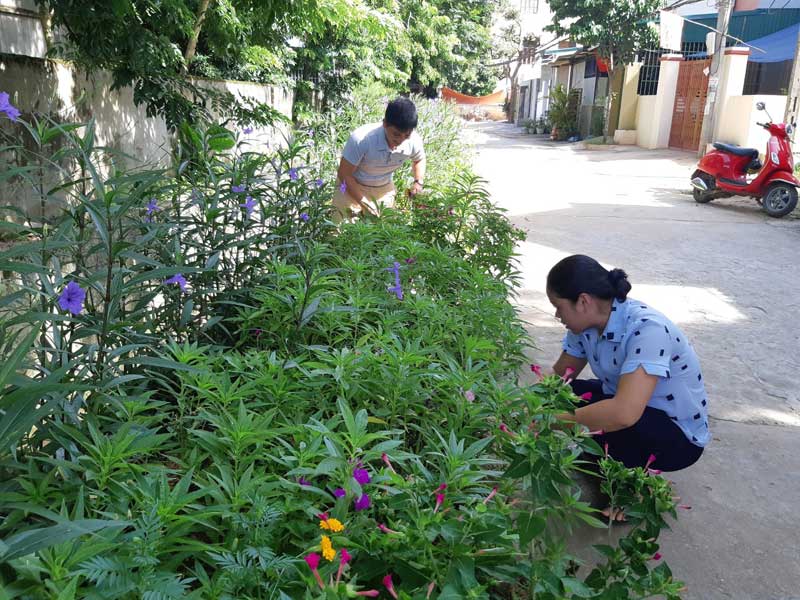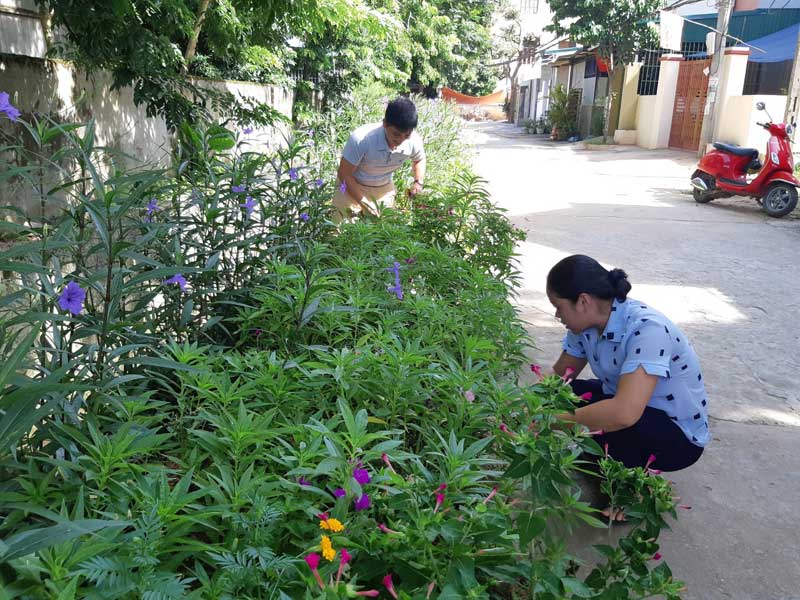
(HBO) - At the end of July, communes in Yen Thuy district enthusiastically took part in the first contest for model residential areas and advanced new-style rural communes, which was held by the district’s Vietnam Fatherland Front (VFF) Committee and socio-political organisations. Other districts also held similar contest in line with the schedule set by the provincial VFF Committee.
 Residents in Dan Chu ward’s
group 13 participate in a model named "civilised streets, garbage-free
residential areas".
Residents in Dan Chu ward’s
group 13 participate in a model named "civilised streets, garbage-free
residential areas".
Vice Chairman of the provincial VFF Committee Dang Bich Ngoc
said the contest contributed to promoting and improving the effectiveness of
the campaign "All people unite to build new rural area, urban civilisation"
sponsored by the VFF. On April 8, 2016, the provincial Party Committee issued
Directive No. 13-CT/TU on strengthening the Party's leadership over the campaign.
Thanks to concerted efforts from both the political system and
the people, local rural and urban areas have been given a facelift. During the 10
years implementing new-style rural building, locals have donated 109.72 billion
VND (4.7 million USD), over 2.4 million working days, over 979,000 m2 of land,
and more than 2.3 trillion VND worth of materials and machines.
The province has formed large-scale concentrated production
areas and consolidated the brand names of many products such as Hoa Binh purple
sugarcane, Cao Phong orange, Tan Lac red pomelo, Son Thuy longan, Da river
fish, and Lac Thuy goat.
The province is home to 500 production models and 22 value
chains. A large number of models in residential areas have been built,
replicated, and promoted effectively. They included the "civilised streets,
garbage-free residential areas" model in Hoa Binh city; and the "residential
areas self-managing environmental sanitation and promoting mutual support for
economic development” in Tan Lac district.
As of June 2020, there were 53 communes recognized as
new-style rural areas and 39 residential areas meeting standards for model
new-style rural areas./.
With an increasingly vibrant and widespread emulation movement aimed at building cultured residential areas and cultured families, Yen Thuy District has been making steady progress toward improving both the material and spiritual well-being of its people, while fostering a civilized, prosperous, beautiful, and progressive community.
Once lacking recreational spaces and community facilities, Residential Group 2 in Quynh Lam Ward (Hoa Binh City) has recently received attention for the construction of a new, spacious, and fully equipped cultural house. The project followed the model of state support combined with public contributions in both labor and funding.
The "All people unite to build cultural life" movement, which has been effectively integrated with Kim Boi district’s socio-economic development goals, is fostering a lively spirit of emulation across local residential areas, hamlets, villages, public agencies, and enterprises. In addition, through the initiative, traditional cultural values are being preserved and promoted, while community solidarity and mutual support in poverty reduction and economic development are being strengthened.
A working delegation of the Hoa Binh provincial People’s Committee led by its Permanent Vice Chairman Nguyen Van Toan on June 11 inspected the progress of a project to build the Mo Muong Cultural Heritage Conservation Space linked to tourism services in Hop Phong commune, Cao Phong district.
Born and growing in the heroic land of Muong Dong, Dinh Thi Kieu Dung, a resident in Bo town of Kim Boi district, in her childhood was nurtured by the sweet lullabies of her grandmother and mother. These melodies deeply imprinted on her soul, becoming an inseparable part of her love for her ethnic group's culture. For over 20 years, this love for her hometown has driven Dung to research, collect, and pass down the cultural values of the Muong people to future generations.
In the final days of May, the Ethnic Art Troupe of Hoa Binh Province organized performances to serve the people in remote, mountainous, and particularly disadvantaged areas within the province. These were not just ordinary artistic shows, but they were the meaningful journeys aimed at spreading cultural values, enhancing the spiritual life of the people and contributing to the preservation of ethnic minority cultural identities.



 Residents in Dan Chu ward’s
group 13 participate in a model named "civilised streets, garbage-free
residential areas".
Residents in Dan Chu ward’s
group 13 participate in a model named "civilised streets, garbage-free
residential areas".